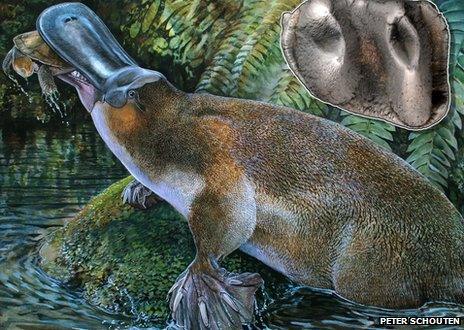'Platypus-zilla' fossil unearthed in Australia
- Published

The giant platypus would have measured more than 1m (3ft) in length
Part of a giant platypus fossil has been unearthed in Queensland, Australia.
Scientists have dubbed the beast "platypus-zilla" and believe it would have measured more than 1m long (3ft).
Writing in the Journal of Vertebrate Paleontology, external, the researchers say the creature lived between five and 15 million years ago.
The discovery suggests the evolutionary back-story of today's platypus is more complicated than was thought.
Prof Mike Archer, from the University of New South Wales, said: "Suddenly up pops 'playtpus-zilla' - this gigantic monstrosity that you would have been afraid to swim with.
"It indicates there are branches in the platypus family tree that we hadn't suspected before."
Bizarre looks
Today, all that survives of this platypus is a single fossilised tooth, which was unearthed in the Riversleigh fossil beds in northwest Queensland.
Based on its size, the researchers have estimated that the new species (Obdurodon tharalkooschild) would have been at least twice as large as today's platypus.
Bumps on its teeth and other fossil finds nearby suggest that the creature feasted on crustaceans, turtles, frogs and fish.
Although the area where the molar was found is a desert, millions of years ago it would have been covered in forest. The researchers think the beast would have spent its time in and around freshwater ponds.

The platypus is described from a single molar that was found in Queensland
Prof Archer said that with just one tooth, it was difficult to work out exactly what this species would have looked like.
However other fossils suggest that it could have shared the same bizarre appearance as today's platypuses, with their duck-like bills, large webbed feet and poisonous spurs. But this would have been on a much larger scale.
"I guess it probably would have looked like a platypus on steroids," said Prof Archer.
Fossil platypus finds are in short supply, with just a few fragments found throughout the southern hemisphere.
As a result, there are many gaps in our understanding of the creature's past.
Prof Archer said: "We have been naively led to suspect that maybe it was just one lineage of strange animals bumbling its way through time and space at least for the last 60 million years.
"The discovery of this new one was a bit of a shock to us. It was a wake-up call that the platypus's story, the more we know about it, is increasingly more complicated than we thought."
The researchers are now hoping to find more platypus fossils in the same area to try to shed more light these enigmatic Australian animals.
Follow Rebecca on Twitter, external
- Published8 February 2013